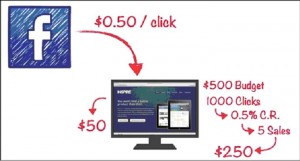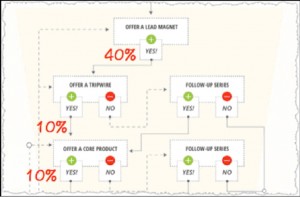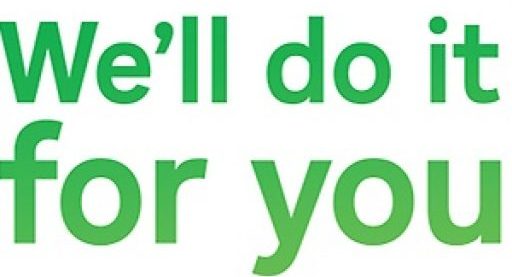There’s no such thing as a “traffic problem.”
I’ll say that again: There’s no such thing as a “traffic problem.”
If you want website traffic, it is available. No matter what market you’re in, it is available. Whether you buy it from Facebook, Google, LinkedIn or contract affiliates to send you traffic — it is available. (And that’s just to name a few obvious traffic sources.)
Smart marketers treat traffic like a water faucet. When they want some, they turn it on.
So if you’re not generating as much traffic as you would like, chances are you have a strategy problem. Fortunately, we can fix that…
The key to the traffic game is to build a system that allows you to acquire traffic at a profit. Yep… a system that pays you to acquire traffic.
Is it free? No – it’s better than free. You can actually get paid to drive traffic.
Here’s the big secret…
You need to make more money from the traffic you get than it costs you to acquire that traffic in the first place.
Big breakthrough, right?
In other words, you need to learn to spend $1 on advertising and earn more than $1 back. Then repeat.
It’s like building a machine that you put a quarter in and a dollar pops out.
Sound too good to be true? The truth is that machines like this exist all around you. These machines are the successful businesses that generate profits year after year by mastering the art of the conversion funnel.
If you pay close attention to the lessons in this article, you’ll no longer worry about generating traffic to your website. Instead, you’ll go to work on your conversion funnel and when you’re ready… you’ll turn the traffic on like a water faucet.
Let’s look at an example…
Let’s say you are generating traffic from one of my favorite traffic sources: Facebook. Traffic from Facebook is inexpensive and scales well, and we’ve yet to find a market that isn’t a good fit for Facebook traffic.
We’re going to look at two scenarios. One where a business is profitable and the other… well… not so much. (Hold on to your hat and indulge me for just a minute while I talk numbers.)
Scenario 1 (Don’t do this)
Here are the details of this campaign,
- $0.50/click to drive traffic from a Facebook Ad
- The offer costs $50
- $500 advertising budget drives 1000 clicks from Facebook
- 5% conversion rate on the $50 offer
- That generates 5 sales for a total of $250
Hmmmm… we spent $500 to earn $250.
Not very exciting is it? But this is exactly the experience that most people have when they buy traffic. They run cold traffic to a higher-dollar offer and they lose their shirt.
In fact, that 0.5% conversion rate might be a little generous when making higher dollar offers to cold traffic.
So here’s what we do that makes all the difference…
Scenario 2 (Do this)
These are the variables in this campaign that stay constant from Scenario 1,
- $0.50/click to drive traffic from a Facebook Ad
- $500 advertising budget drives 1000 clicks from Facebook
- $50 core offer price point
But, instead of driving cold traffic to a $50 core offer, we instead drive that traffic to a landing page offering a small chunk of value for free in exchange for the prospect’s contact information.
We call that small chunk of value a Lead Magnet.
Those that opt in to receive the Lead Magnet will then see an offer for a low-dollar “front end” product. In this case, the offer is at a $10 price point.
We call that low-dollar “front-end” offer a Tripwire.
Only buyers of the $10 offer will be made the $50 offer. Here’s what that funnel looks like,
- $0.50/click to drive traffic from a Facebook Ad
- $500 advertising budget drives 1000 clicks from Facebook to the Lead Magnet
- 40% opt-in rate for the free Lead Magnet generates 400 leads
- 400 leads are offered the $10 Tripwire offer
- 10% conversion rate on the Tripwire generates 40 sales ($400 in revenue)
- 40 buyers are offered the $50 Core Offer
- 10% conversion rate on the Core Offer generates 4 sales ($200 in revenue)
Now we’ve spent $500 to earn $600. That’s more like it.
Not only have we earned $100, but we’ve also acquired 400 new leads and, more importantly, 40 new buyers.
All of the opt-in and conversion rates I used in these examples are based on the averages across a number of markets and… to be honest… I used very conservative numbers.
Notice how critical the Tripwire is to generating a profit on your traffic spend in Scenario 2? Without the Tripwire, you lose. With it, you acquire new customers at a profit.
But the funnel in Scenario 2 also makes money (while the first funnel doesn’t) because it uses the correct sequence. The second funnel doesn’t ask for a marriage proposal on the first date. It warms you up with a Lead Magnet and graduates to a low-dollar Tripwire offer before asking for much of a commitment.
Here’s the key to perpetual traffic…
40/10/10
If you can build a funnel with a 40/10/10 conversion rate ratio, you’ve unlocked the key to perpetual traffic.
That means…
- 40% conversion rate on the Lead Magnet
- 10% conversion rate on the Tripwire
- 10% conversion rate on the Core Offer

But it doesn’t have to stop there. In fact, you’d be crazy to stop there.
Once you have a buyer, you should ask them to buy something else. They bought the Tripwire and they bought the Core Offer — some percentage of those buyers will want more.
Give it to them.
Remember, at this point all of your customer acquisition costs are covered. You’re generating new leads and customers at break even or better.
Everything else they buy is pure profit.
